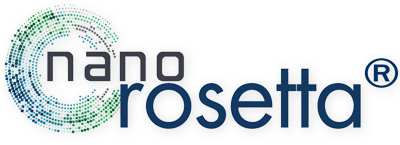NanoRosetta® Technology
NanoRosetta® NanoFiche Archival
Production Process
For the production of nano inscribed nickel wafers or plates, the archival data in the form of pdf format is first submitted and organized sequentially or indexed systematically. After file conversion and other preparation for NanoRosetta processing, the documents or other data are then recorded onto a glass wafer by modulating a laser beam in a spiral or concentric manner using a polar raster direct laser etch. A matrix process in electroforming creates “father” nickel master from the inscribed glass wafer. An intermediate “mother” and final ”son” can then be generated from this nickel “father” master wafer. For mass production, polymer copies can also be provided in lieu of nickel “sons.” We also have the ability to combine digital data (CD or DVD) and analog human readable formats on the same disc,
Why adopt NanoRosetta for permanent archival preservation?
- Nickel has a much longer life span than microfilm, up to thousands of years.
- Nickel is resistant to high temperatures, water damage, and electromagnetic disruption, eliminating the need for expensive control of temperature and humidity.
- No need for future migration of digital data, as long as a microscope (lenses) and light (sun) are available.
- High speed recording of analog data, preserving more documents in a much shorter time.
- High density, reducing precious storage space.
- No more energy cost to store mass amounts of information.
What file formats can I submit?
For analog information, customer documents or files for NanoRosetta archiving should be provided in PDF or TIFF format at the highest resolution possible. The analog files will then be converted and combined into larger files that can then be stitched together by the NanoRosetta process.
For digital information, customer documents or files to be stored should be provided in a DDP (Disc Description Protocol) format either as a CD or DVD format.
Since both the analog and data information compete for the same space on the wafer, there is a trade off on how much of each data can be stored.
What do you need from me?
The customer must provide the archival material and is responsible for organizing the data, including arranging such data according to their own preferred indexing scheme. The customer is also responsible for their own retrieval system. Automated inspection systems for wafers work wonderfully well as well as high resolution digital cameras. Digital imaging technology has been progressing at neck break speed and it is not unimaginable to foresee 100MB Pixel or GigaPixel cameras that can recover all the pages in a single shot in the near future. Our recording technology is just ahead of this curve.
Page Capacity
A small number of pages printable in a large format or a large number of pages printable in nano scale can be etched utilizing the NanoRosetta process. Ten thousand pages or more would not be unusual. A 160 mm nickel wafer can hold up to over 81,000 pages. Since there are always trade offs in reduction to practice, larger fonts and larger texts will reduce the number of pages but will be easier to access and recover with lower resolution optical devices. In some cases, if the pages are large enough, an entire book can be recovered with a single high resolution digital camera image capturing all the pages. The pages can be parsed out by software codes, page by page, to get the entire book back within minutes.
Layout
Since the NanoRosetta process utilizes a round glass wafer to direct laser etch, the layout follows the contour of polar coordinates. To maximize the capacity of a disc, the pages are laid out from any direction left to right, top to down to fill the contour of a disc. Alternatively the pages can be laid out in blocks to correspond to any logical configuration that would facilitate ease of retrieval. For example a block can hold 1,000 pages of a book or annual publication. A group of such blocks can preserve an entire collection.
Speed
We can print 80,000 pages per hour.
Wafer or Plate Size
Standard wafers are provided on either a round 160 mm or 138 mm diameter nickel wafer at 300 microns thickness. Typically, there is a 25 mm diameter blank circle in the center of each nickel wafer and a hole of 15mm diameter is punched for alignment. Though wafer versions can be provided with no center hole, data cannot be inscribed in the central area of the wafer. Data also is not written right to the edge either to allow for some margins of error in the manufacturing process. A practical edge should be from radius 10mm to a maximum of 60mm of nano inscribed data. Specialty shapes can also be provided.
Alternatively 120 mm CD sized plastic discs can be produced. For the plastic CD discs, a larger limitation is imposed for space due to the injection molding process. The center blank area is 36mm and reduces the amount of space that analog data can be printed.
Turn Around Time
Operations time depends upon how the data is presented and the quantity of pages or files submitted by the customer. For the first inscriptions onto the glass premaster approximately 80,000 pages per hour can be written. Making the nickel masters can take several hours to days depending upon how many final wafer copies are required. The most time consuming element in the NanoRosetta process is the preparation, organization, manipulation and rendering of the data prior to the inscription process. Since the NanoRosetta process must render close to a trillion pixels for an archival wafer, the limitation is the computing power. Once the rendered master file has been compiled, the manufacturing process takes much less time.
